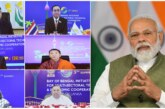Undoubtedly, meeting the #challengesofclimatechange is a formidable task and any delay in curbing #greenhousegasemissions can be perilous; nevertheless, solutions are also nearby. The alternative sources of #cleanenergy which have registered tremendous strides can be harnessed judiciously. Besides, judicious use of #water and other #naturalresources along with eliminating deforestation can be helpful in limiting warming to two degrees Celsius over pre-industrial levels. According to a UN climate report, the Himalayan glaciers that are the sources of Asia’s ‘s biggest rivers – #Ganges, #Indus, #Brahmaputra, #Yangtze, #Mekong, #Salween and #Yellow – could disappear by 2035 as #temperaturesrise. It was later revealed that the source used by the #UNclimatereport actually stated 2350, not 2035. Approximately 2.4 billion people live in the drainage of the #Himalayanrivers. #Waterscarcity has many negative impacts on the #environment, including #lakes, #rivers, #wetlands, and other #freshwaterresources. The resulting water overuse that is related to #waterscarcity, often located in areas of #irrigationagriculture, harms the #environment in several ways including increased #salinity, #nutrientpollution, and the loss of #floodplains and #wetland
Despite its growing prosperity, India has the highest burden of #malnutrition in the world. Malnutrition is an underlying cause of almost half of all child deaths, and, for those children who survive, leads to cognitive impairment that prevents tens of millions of children from ever reaching their potential due to #waterquality and #depletionofwaterresource, #lackofnutrition in soil and food items. The #WorldBank estimates that #India is one of the highest ranking countries in the world for the number of children suffering from malnutrition . The prevalence of underweight children in India is among the highest in the world, and is nearly double that of Sub-Saharan Africa with dire consequences for #mobility, #mortality, #productivity and #economicgrowth.
Currently, the country is undergoing a rapid #socioeconomic, #demographic, #nutritional and #healthtransition. Although India has not yet overcome the #problemsofpoverty, under nutrition and communicable diseases, it is increasingly facing additional challenges related to the affluence that results from #industrialization, #urbanization and #economicbetterment. Over the last two decades, over nutrition and obesity have emerged as #publichealthproblems; there have been increases in the prevalence of #diabetes and #cardiovasculardisease (CVD), especially in #urbanareas. The magnitude of these problems varies among states and socio-economic strata and between urban and #ruralareas, and it is a matter of concern that these diseases occur a decade earlier in India than elsewhere and that they affect poor segments of the population and those in rural areas. Case fatality rates are reported to be higher in poor and rural populations, probably because of poor #accesstohealthcare and consequent delayed diagnosis and treatment. The impact of ongoing socio-economic, demographic and life style transitions on #nutritionalstatus, and the health implications of the ongoing nutrition transition.
One of the major causes for malnutrition in India is gender inequality. Due to the low social status of Indian women, their diet often lacks in both #quality and #quantity. Women who suffer malnutrition are less likely to have healthy babies. In India, mothers generally lack proper #knowledgeinfeedingchildren. Consequently, new born infants are unable to get adequate amount of nutrition from their mothers.
According to the #WHO constitution, the highest attainable standard of health is a #fundamentalrightofeveryhumanbeing. Despite being one of the world’s fastest growing economies during the past decades, India’s health-care indicators are among the worst among #developingcountries. India’s various health-care challenges need to be tackled efficiently and urgently to #sustaineconomicgrowth and #decreaseinequalities.
#MalnutritionandLoomingHealthCare
In India’s health-care system, nearly 70% of overall health spending is incurred by private out-of-pocket expenditure, and 70% of this is spent on medicines. Private out-of-pocket expenditure on health pushed 60 million Indians below the poverty line in 2010. The government should constitute a #NationalMedicalServiceCorporation with mandate to procure and provide generic medicine, surgical, and suture goods to all #publichealthinstitutions across the country. Furthermore, the government should institutionalise the #NationalHealthRegulatoryandDevelopmentAuthority (#NHRDA) for setting normative standards to be followed, including standard treatment guidelines, prescription audits, and quality assurance methods. Improved integration of the health and social development sectors is urgently needed. The government should address the causal factors responsible for ill health and start campaigning for a healthy India and a health in all policies approach, with increasing access to basic services, such as #water and #toilets, #nutrition, #publichealth at the #communitylevel, and promotive health.
Malnutrition refers to the situation where there is an unbalanced diet in which some nutrients are in excess, lacking or in wrong proportion. Simply put, we can categorise it to be under-nutrition and over-nutrition. Despite India’s 50% increase in #GDP since 1991, more than one third of the world’s malnourished children live in India. Among these, half of them under 3 are underweight and a third of wealthiest children are over-nutriented. In general, those who are poor are at risk for under-nutrition, while those who have high #socioeconomicstatus are relatively more likely to be over-nourished. #Anaemia is negatively correlated with wealth.
#GovernmentInitiatives
India has been struggling to achieve universal sanitation coverage since 1986 when it launched the #CentralRuralSanitationProgramme, a supply-driven scheme with subsidy. In 1999, the programme was recast as demand-driven #TotalSanitationCampaign (#TSC), but again with subsidy. In 2012, it was re-christened #NirmalBharatAbhiyan (#NBA) with the focus on community-led, demand-driven approach, but with even more subsidies. The fact remains that India has the world’s largest population that defecates in the open. According to data released by the #NationalSampleSurveyOffice (#NSSO) in December 2013, 59.4 per cent of rural India defecates in the open. #Jharkhand and #Odisha are the worst performers with 90.5 per cent and 81.3 per cent of their #population without toilets. Indeed, different government agencies provide different data on the number of #ruralhouseholdswithtoilets. The 69th survey conducted by the National Sample Survey Office between July and December 2012 has put the figure at 41 per cent, the Baseline Survey’s abstract report accessed on December 2013 at 40 per cent, and the 2011 Census at 31 per cent.
“Currently, different ministries running nutrition related schemes were working in silos. It was felt that convergence between ministries with sectoral commitment to nutrition will be more effective in addressing the problem,” said a #WCDministryofficial.
According to #UNESCAP report: However, India has not been spending enough on #humandevelopment resulting in generally poorer outcomes in such areas as #health, #nutrition, #qualityofeducation (including #skillsdevelopment), and #sanitation and #hygiene, compare to developing Asia as whole and particularly compared to East Asia, which has surged far ahead. In health, for example, where India is particularly underperforming, it spend 4.05% of its #GDP, compared to 6% to 12% in upper middle and high income countries, respectively. Only a third of India’s health spending comes from public funds (1.34% of #GDP) and the gap is funded by households, Out of their pockets. It has been estimated that 6.2% of households in India fall below the #povertyline, due to health spending that they cannot afford.12
In education too, India’s performance is less than satisfactory, with public expenditure on education at 3.34% of GDP against the #UNESCO norm of 6% of GDP.13
In South Asia, the pace of sanitation improvements has not kept up with population growth: in 2010 the region had about 1,057 million people without improved sanitation. Worse, 692 million people in South Asia have no toilet at all, and defecate in the open. In India alone, some 625 million people practice #opendefecation. The objective of achieving the sanitation #MDG target appears apparently a near-impossible task given the trend over the past 20 years. #Lackofsanitationfacilities, open defecation and pollution of water resources affect the #qualityofwater. Consumption of contaminated water leads to #waterbornediseases which claim heavy toll on human health.
#WaterandChallengesofHealthHazards
Millions of litres of untreated sewage water and #industrialwastewater with effluents enter the major #nationalriversofIndia daily, thereby polluting it with #toxicchemicals and high level of #coliform and other #bacteria. The high level of coliform bacteria increases the incidence of water-borne diseases. These microbes grow in the intestines of humans and animals, where they multiply and thereby cause disease. These water-borne pathogens survive under low temperature, #lowsalinity and #lowintensityoflight. Warm temperature is favourable for their #rapidgrowth.
#Chemicalcontaminants (#fluoride, #arsenic, and #selenium) pose a very serious health hazard in India. It is estimated that about 70 million people in 20 states are at risk due to excess fluoride and around 10 million are at risk due to excess arsenic in #groundwater. Apart from this, increases in the #concentrationofchloride, #TDS, #nitrate, and #ironingroundwater are of great concern for a #sustainabledrinkingwaterprogramme. With over-extraction of groundwater the concentration of chemicals is increasing regularly.
#Pollutionofgroundandsurfacewaters from #agrochemicals (#fertilizersandpesticides) and from industry poses a major #environmentalhealthhazard, with potentially significant costs to the country. The World Bank has estimated that the total cost of #environmentaldamage in India amounts to US$9.7 billion annually, or 4.5% of the gross domestic product. Of this, 59% results from the health impacts of #waterpollution.
#HumanHealthImpactsandClimateChange
Climate change can have both direct and indirect human health impacts. Direct impact is heat and cold related stress. Indirect impacts arise from changes in temperature patterns, which may #disturbnaturalecosystems, change the #ecology of infectious diseases, #harmagriculture and #freshwatersupplies, exacerbate air pollution levels, and cause large-scale reorganization of plant and animal communities.
As the economist Dean Spears has written, “Because the problems that prevent children from growing tall also prevent them from growing into healthy, productive, smart adults, height predicts adult economic outcomes and cognitive achievement.” In short, India’s #malnutrition crisis is not just bad for India’s malnourished children; it also limits the country’s economic progress. Moreover, India has the schemes in place to drive rapid improvements in health. The #NationalRuralHealthMission was created in 2005 and provides a framework by which the government can support the health goals outlined at the sub-district, district and state levels.
But there is more India can do to advance health. First and foremost, public spending on healthcare in India is extremely low – 1.1% of #GDP. That compares to 2.4% in China and 4.9% in Brazil, two other rapidly growing countries that are wisely betting on health as a key component of growth.
The #globalclimate is now changing faster than at any point in human civilization, and many of the effects on health will be acutely felt. The most severe risks are to #developingcountries, with negative implications for the achievement of the health related #MillenniumDevelopmentGoals and for healthy equity. Change in world climate would influence the functioning of many #ecosystems and their member species.
#ChallengesandWayForward
Challenges like absence of convergence, yawning gaps in the formulation and implementation of policies and lack of collective approach to address #HealthWaterSanitation sectors can be transformed into opportunities through judicious management of these sectors with the help of local communities and the civil society. It has been amply demonstrated that projects with community inputs are more successful in reaching the greatest number of affected people with long-lasting services. Other benefits include lower costs, greater acceptance of the technology, and better maintenance of facilities by the users. In order to #regulatepollution, changes in government policies are required; community participation along with civil society inputs is also necessary to ensure the success of policies in #HealthWaterSanitation sectors.
By #DrArvindKumarPresidentIndiaWaterFoundation



